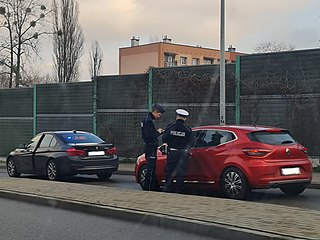Terry v. Ohio, 392 U.S. 1 (1968), was a landmark U.S. Supreme Court decision in which the court ruled that it is constitutional for American police to "stop and frisk" a person they reasonably suspect to be armed and involved in a crime. Specifically, the decision held that a police officer does not violate the Fourth Amendment to the U.S. Constitution's prohibition on unreasonable searches and seizures when questioning someone even though the officer lacks probable cause to arrest the person, so long as the police officer has a reasonable suspicion that the person has committed, is committing, or is about to commit a crime. The court also ruled that the police officer may perform a quick surface search of the person's outer clothing for weapons if they have reasonable suspicion that the person stopped is "armed and presently dangerous." This reasonable suspicion must be based on "specific and articulable facts," and not merely upon an officer's hunch.
A Terry stop in the United States allows the police to briefly detain a person based on reasonable suspicion of involvement in criminal activity. Reasonable suspicion is a lower standard than probable cause which is needed for arrest. When police stop and search a pedestrian, this is commonly known as a stop and frisk. When police stop an automobile, this is known as a traffic stop. If the police stop a motor vehicle on minor infringements in order to investigate other suspected criminal activity, this is known as a pretextual stop. Additional rules apply to stops that occur on a bus.

A traffic stop, colloquially referred to as being pulled over, is a temporary detention of a driver of a vehicle and its occupants by police to investigate a possible crime or minor violation of law.
Reasonable suspicion is a legal standard of proof that in United States law is less than probable cause, the legal standard for arrests and warrants, but more than an "inchoate and unparticularized suspicion or 'hunch'"; it must be based on "specific and articulable facts", "taken together with rational inferences from those facts", and the suspicion must be associated with the specific individual. If police additionally have reasonable suspicion that a person so detained is armed and dangerous, they may "frisk" the person for weapons, but not for contraband like drugs. However, if the police develop probable cause during a weapons frisk, they may then conduct a full search. Reasonable suspicion is evaluated using the "reasonable person" or "reasonable officer" standard, in which said person in the same circumstances could reasonably suspect a person has been, is, or is about to be engaged in criminal activity; it depends upon the totality of circumstances, and can result from a combination of particular facts, even if each is individually innocuous.
Atwater v. Lago Vista, 532 U.S. 318 (2001), was a United States Supreme Court decision which held that a person's Fourth Amendment rights are not violated when the subject is arrested for driving without a seatbelt. The court ruled that such an arrest for a misdemeanor that is punishable only by a fine does not constitute an unreasonable seizure under the Fourth Amendment.
Illinois v. Caballes, 543 U.S. 405 (2005), is a decision by the Supreme Court of the United States in which the Court held that the use of a drug-sniffing police dog during a routine traffic stop does not violate the Fourth Amendment to the U.S. Constitution, even if the initial infraction is unrelated to drug offenses.
Ohio v. Robinette, 519 U.S. 33 (1996), was a United States Supreme Court case in which the Court held that the Fourth Amendment does not require police officers to inform a motorist at the end of a traffic stop that they are free to go before seeking permission to search the motorist's car.

A random checkpoint is a military and police tactic. In a military context, checkpoints involve the setup of a hasty roadblock by mobile truck- or armored vehicle-mounted infantry to disrupt unauthorized or unwanted movement or military activity and to check for valid identification and search for contraband, fugitives, or weapons that are not permitted in civilian hands. Random checkpoints are set up to achieve surprise, as opposed to known permanently located checkpoints, which suspects could circumvent. They are often established in locations where they cannot be observed by approaching traffic until it is too late to withdraw and escape without being observed.
Brendlin v. California, 551 U.S. 249 (2007), was a decision by the Supreme Court of the United States that held that all occupants of a car are "seized" for purposes of the Fourth Amendment during a traffic stop, not just the driver.

United States v. Brignoni-Ponce, 422 U.S. 873 (1975), was a case in which the Supreme Court determined it was a violation of the Fourth Amendment for a roving patrol car to stop a vehicle solely on the basis of the driver appearing to be of Mexican descent. A roving patrol car must have articulable facts that allow for an officer to have a reasonable suspicion that the person is carrying illegal aliens beyond their ethnicity. The Court handed down a 9–0 decision that affirmed the Circuit Court's ruling in the case. This case was also the final case that William O. Douglas presided on, as he retired shortly after this case, ending his record 36 years as an Associate Justice.
Whren v. United States, 517 U.S. 806 (1996), was a unanimous United States Supreme Court decision that "declared that any traffic offense committed by a driver was a legitimate legal basis for a stop."
Arizona v. Johnson, 555 U.S. 323 (2009), is a United States Supreme Court case in which the Court held, by unanimous decision, that police may conduct a pat down search of a passenger in an automobile that has been lawfully stopped for a minor traffic violation, provided the police reasonably suspect the passenger is armed and dangerous.
Immigration and Naturalization Service v. Delgado, 466 U.S. 210 (1984), was a United States Supreme Court decision on the limits of worksite enforcement by immigration agents. Specifically, the Court ruled that factory raids by the Immigration and Naturalization Service (INS) were not illegal seizures under the Fourth Amendment to the U.S. Constitution.
United States v. Mendenhall, 446 U.S. 544 (1980), was a United States Supreme Court case that determined "seizure" occurs when an officer uses displays of authority to detain a person.
Heien v. North Carolina, 574 U.S. 54 (2014), was a decision by the United States Supreme Court, ruling that a police officer's reasonable mistake of law can provide the individualized suspicion required by the Fourth Amendment to the United States Constitution to justify a traffic stop. The Court delivered its ruling on December 15, 2014.
Rodriguez v. United States, 575 U.S. 348 (2015), was a United States Supreme Court case which analyzed whether police officers may extend the length of a traffic stop to conduct a search with a trained detection dog. In a 6–3 opinion, the Court held that officers may not extend the length of a traffic stop to conduct a dog sniff unrelated to the original purpose of the stop. However, the Court remanded the case to the United States Court of Appeals for the Eighth Circuit to determine whether the officer's extension of the traffic stop was independently justified by reasonable suspicion. Some analysts have suggested that the Court's decision to limit police authority was influenced by ongoing protests in Ferguson, Missouri.
United States v. Drayton, 536 U.S. 194 (2002), was a case in which the United States Supreme Court clarified the applicability of Fourth Amendment protections to searches and seizures that occur on buses, as well as the function of consent during searches by law enforcement. During a scheduled stop in Tallahassee, Florida, police officers boarded a Greyhound bus as part of a drug interdiction effort and interviewed passengers. After talking to two of the passengers and asking if they could "check [their] person", officers discovered the two passengers had taped several packages of cocaine to their legs. At trial, the passengers argued that officers violated their Fourth Amendment rights against unreasonable searches and seizures because the police engaged in coercive behavior and never informed them that their participation in the drug interdiction efforts was voluntary.
Navarette v. California, 572 U.S. 393 (2014), was a case in which the United States Supreme Court clarified when police officers may make arrests or conduct temporary detentions based on information provided by anonymous tips. In 2008, police in California received a 911 call that a pickup truck was driving recklessly along a rural highway. Officers spotted a truck matching the description provided in the 911 call and followed the truck for five minutes, but did not observe any suspicious behavior. Nevertheless, officers conducted a traffic stop and discovered 30 pounds (14 kg) of marijuana in the truck. At trial, the occupants of the car argued that the traffic stop violated the Fourth Amendment of the United States Constitution, because the tip was unreliable, and officers did not personally observe criminal activity. Writing for a majority of the Court, Justice Clarence Thomas held that the 911 call was reliable, and that officers need not personally observe criminal activity when acting upon information provided by an anonymous 911 call.
Plumhoff v. Rickard, 572 U.S. 765 (2014), is a United States Supreme Court case involving the use of force by police officers during high-speed car chases. After first holding that it had jurisdiction to hear the case, the Court held that the conduct of the police officers involved in the case did not violate the Fourth Amendment to the U.S. Constitution, which prohibits unreasonable searches and seizures.
Kansas v. Glover, 589 U.S. ___ (2020), was a United States Supreme Court case in which the Court held when a police officer lacks information negating an inference that the owner is driving a vehicle, an investigative traffic stop made after running a vehicle's license plate and learning that the registered owner's driver's license has been revoked is reasonable under the Fourth Amendment.



